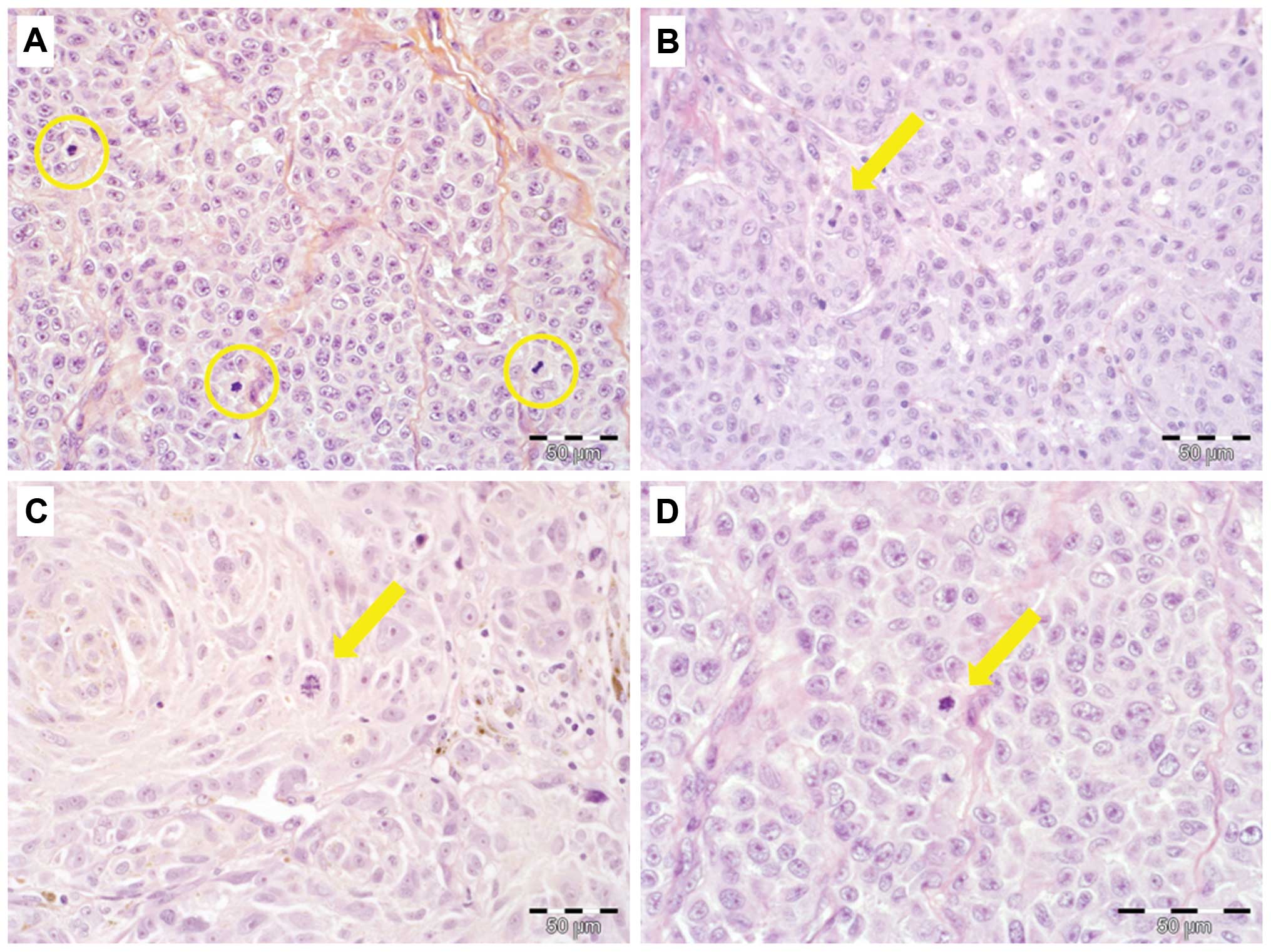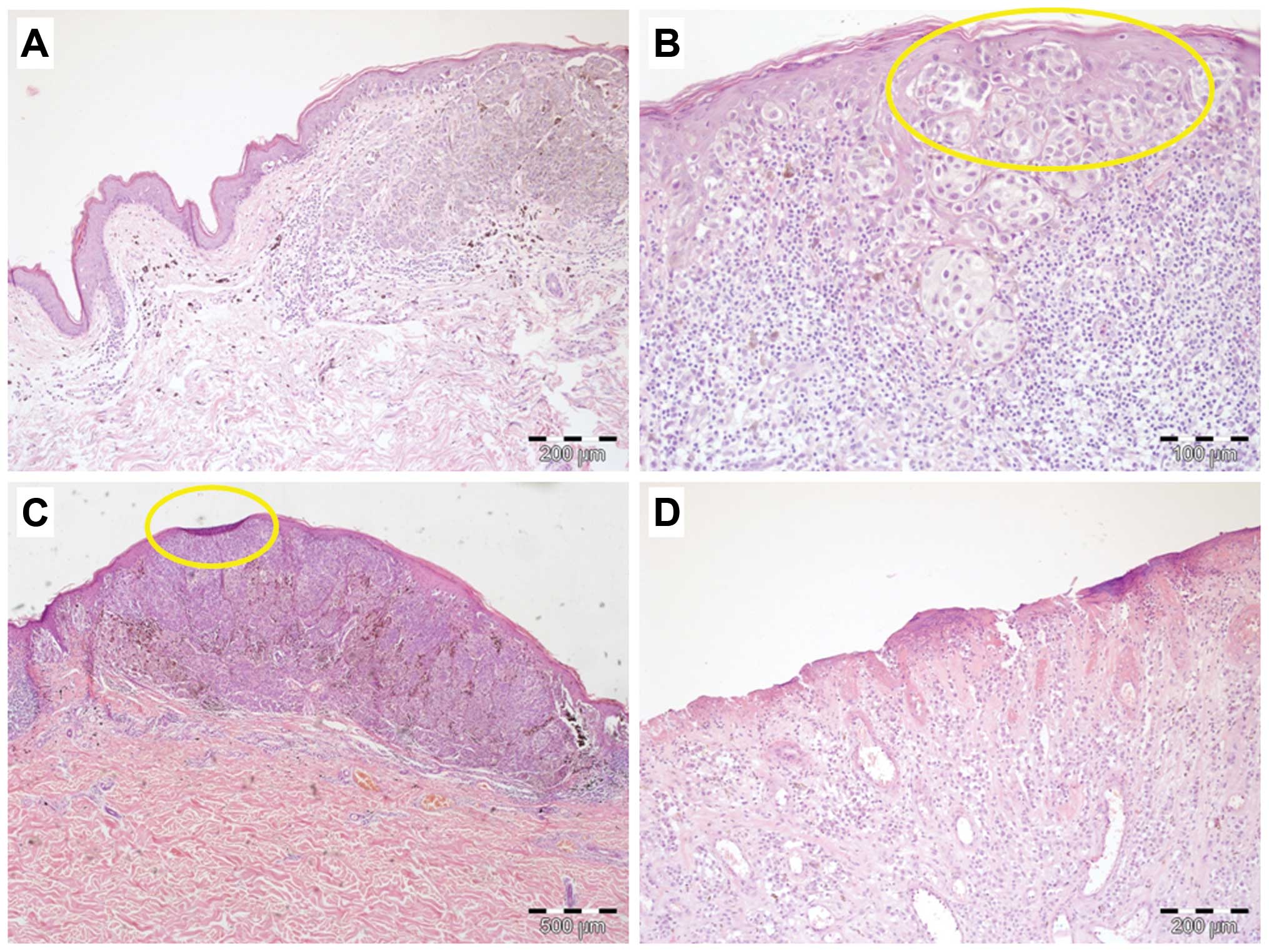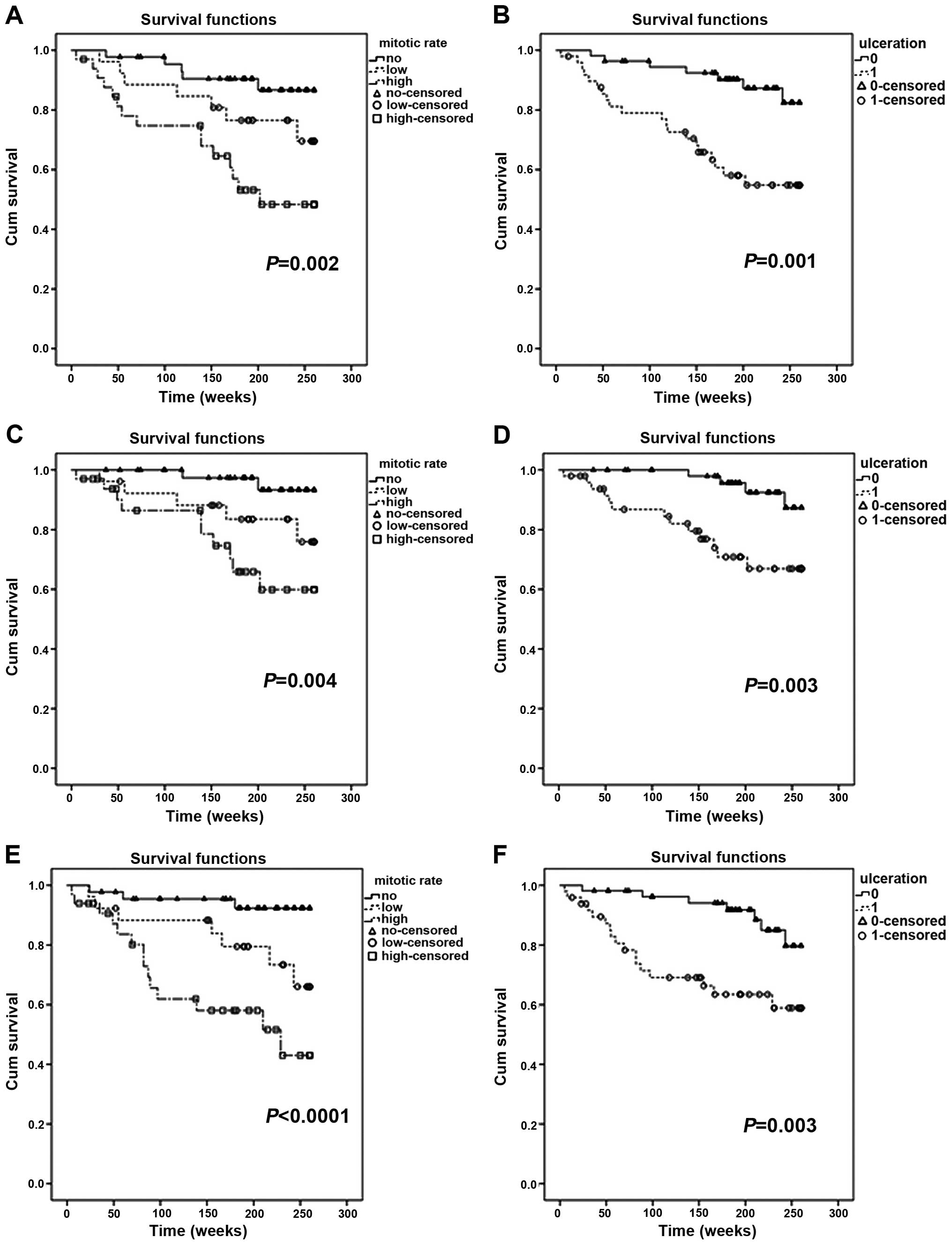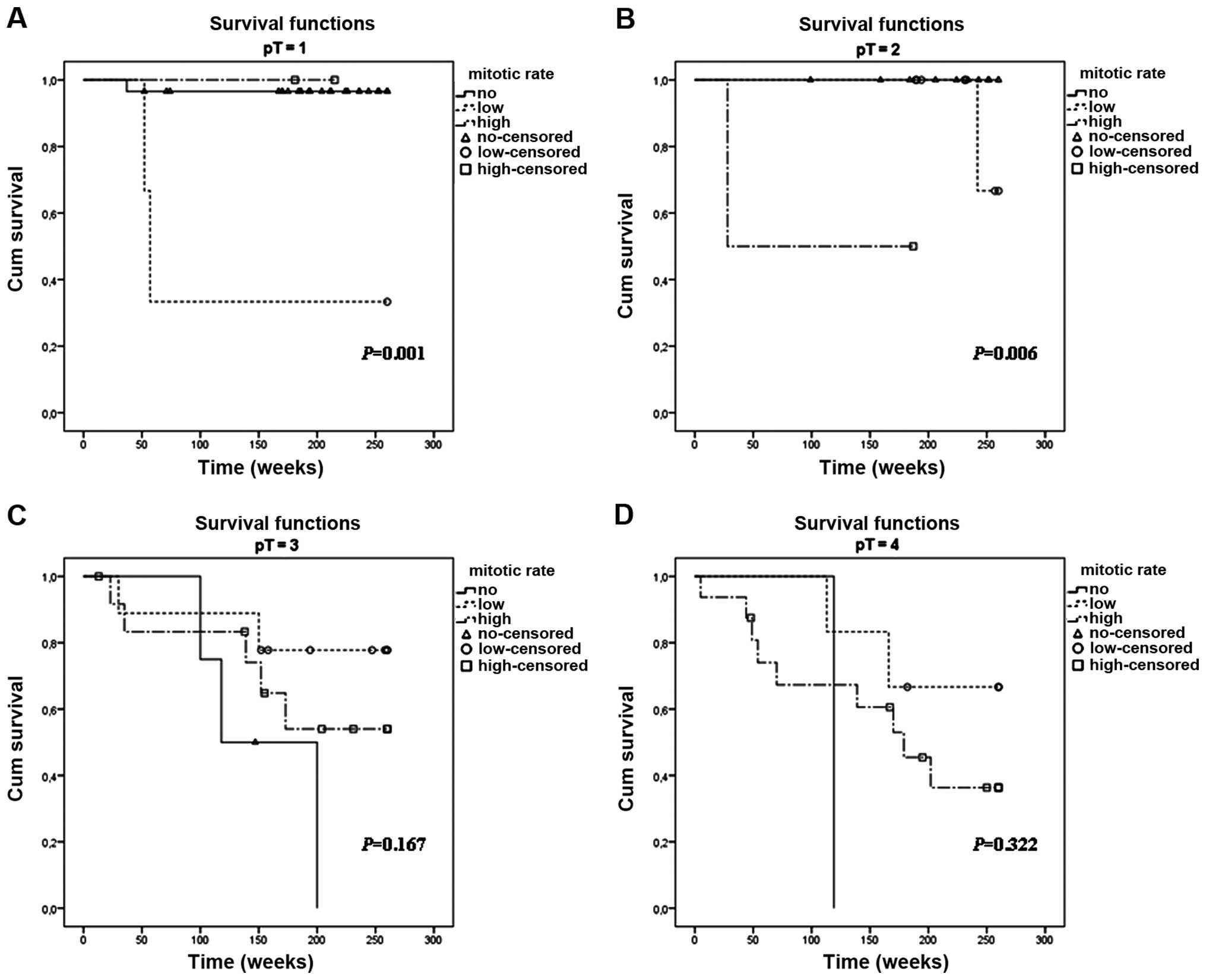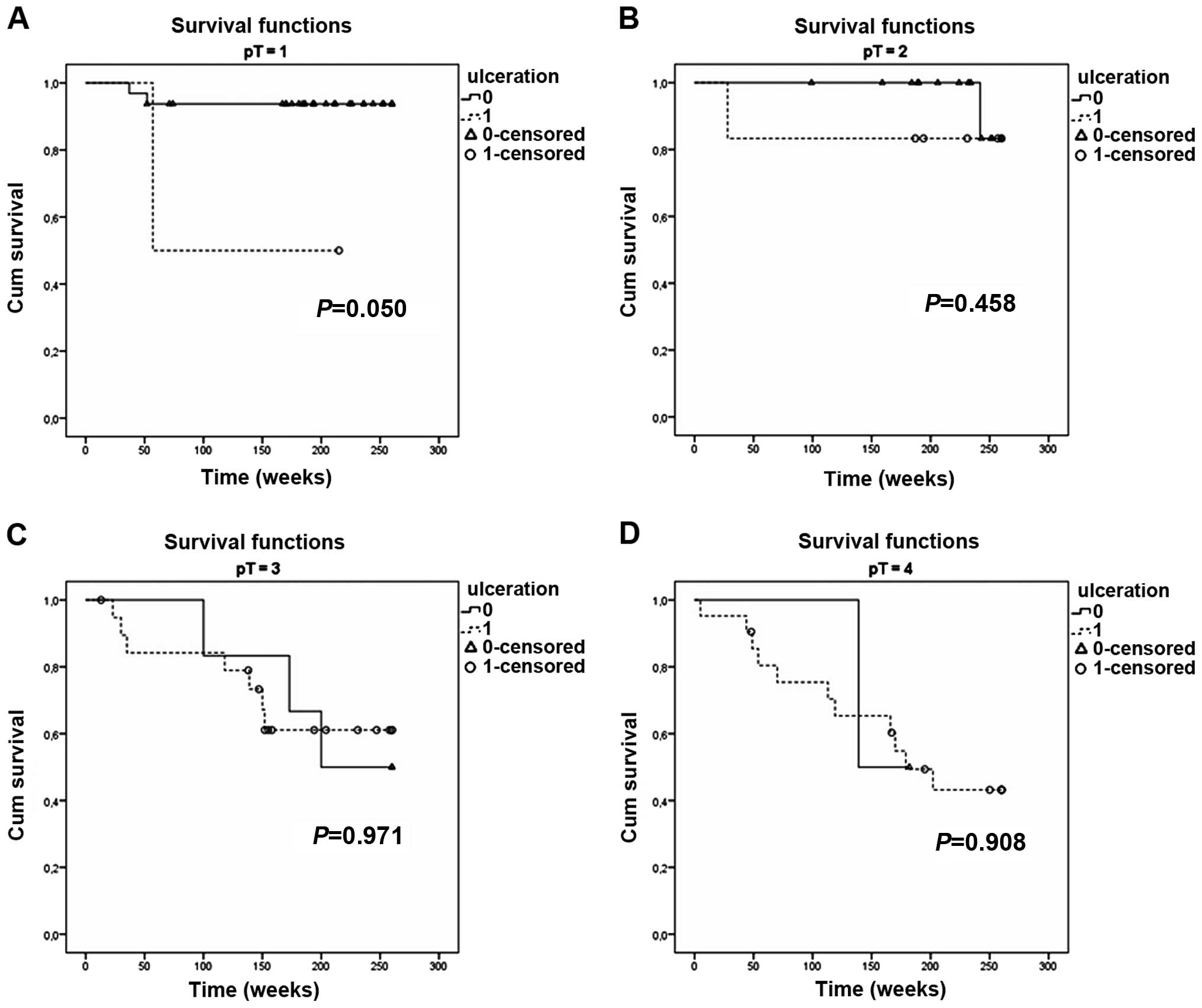|
1
|
Ferlay J, Soerjomataram I, Ervik M,
Dikshit R, Eser S, Mathers C, Rebelo M, Parkin DM, Forman D and
Bray F: GLOBOCAN 2012 Cancer Incidence and Mortality Worldwide.
IARC CancerBase V1.0. (11)International Agency for Research on
Cancer; Lyon: 2013
|
|
2
|
Clark WH Jr, From L, Bernardino EA and
Mihm MC: The histogenesis and biologic behavior of primary human
malignant melanomas of the skin. Cancer Res. 29:705–727.
1969.PubMed/NCBI
|
|
3
|
Breslow A: Thickness, cross-sectional
areas and depth of invasion in the prognosis of cutaneous melanoma.
Ann Surg. 172:902–908. 1970. View Article : Google Scholar : PubMed/NCBI
|
|
4
|
Balch CM, Murad TM, Soong SJ, Ingalls AL,
Halpern NB and Maddox WA: A multifactorial analysis of melanoma:
prognostic histopathological features comparing Clark’s and
Breslow’s staging methods. Ann Surg. 188:732–742. 1978.PubMed/NCBI
|
|
5
|
Balch CM, Soong SJ, Gershenwald JE,
Thompson JF, Reintgen DS, Cascinelli N, Urist M, McMasters KM, Ross
MI, Kirkwood JM, Atkins MB, Thompson JA, Coit DG, Byrd D, Desmond
R, Zhang Y, Liu PY, Lyman GH and Morabito A: Prognostic factors
analysis of 17,600 melanoma patients: validation of the American
Joint Committee on Cancer melanoma staging system. J Clin Oncol.
19:3622–3634. 2001.
|
|
6
|
Balch CM, Gershenwald JE, Soong SJ,
Thompson JF, Atkins MB, Byrd DR, Buzaid AC, Cochran AJ, Coit DG,
Ding S, Eggermont AM, Flaherty KT, Gimotty PA, Kirkwood JM,
McMasters KM, Mihm MC Jr, Morton DL, Ross MI, Sober AJ and Sondak
VK: Final version of 2009 AJCC melanoma staging and classification.
J Clin Oncol. 27:6199–6206. 2009. View Article : Google Scholar : PubMed/NCBI
|
|
7
|
Balch CM, Buzaid AC, Soong SJ, Atkins MB,
Cascinelli N, Coit DG, Fleming ID, Gershenwald JE, Houghton A Jr,
Kirkwood JM, McMasters KM, Mihm MF, Morton DL, Reintgen DS, Ross
MI, Sober A, Thompson JA and Thompson JF: Final version of the
American Joint Committee on Cancer staging system for cutaneous
melanoma. J Clin Oncol. 19:3635–3648. 2001.PubMed/NCBI
|
|
8
|
Thompson JF, Soong SJ, Balch CM,
Gershenwald JE, Ding S, Coit DG, Flaherty KT, Gimotty PA, Johnson
T, Johnson MM, Leong SP, Ross MI, Byrd DR, Cascinelli N, Cochran
AJ, Eggermont AM, McMasters KM, Mihm MC Jr, Morton DL and Sondak
VK: Prognostic significance of mitotic rate in localized primary
cutaneous melanoma: an analysis of patients in the
multi-institutional American Joint Committee on Cancer melanoma
staging database. J Clin Oncol. 29:2199–2205. 2011. View Article : Google Scholar
|
|
9
|
Kesmodel SB, Karakousis GC, Botbyl JD,
Canter RJ, Lewis RT, Wahl PM, Terhune KP, Alavi A, Elder DE, Ming
ME, Guerry D, Gimotty PA, Fraker DL, Czerniecki BJ and Spitz FR:
Mitotic rate as a predictor of sentinel lymph node positivity in
patients with thin melanomas. Ann Surg Oncol. 12:449–458. 2005.
View Article : Google Scholar : PubMed/NCBI
|
|
10
|
Balch CM, Gershenwald JE, Soong SJ,
Thompson JF, Ding S, Byrd DR, Cascinelli N, Cochran AJ, Coit DG,
Eggermont AM, Johnson T, Kirkwood JM, Leong SP, McMasters KM, Mihm
MC Jr, Morton DL, Ross MI and Sondak VK: Multivariate analysis of
prognostic factors among 2,313 patients with stage III melanoma:
comparison of nodal micrometastases versus macrometastases. J Clin
Oncol. 28:2452–2459. 2010. View Article : Google Scholar
|
|
11
|
Azzola MF, Shaw HM, Thompson JF, Soong SJ,
Scolyer RA, Watson GF, Colman MH and Zhang Y: Tumor mitotic rate is
a more powerful prognostic indicator than ulceration in patients
with primary cutaneous melanoma: an analysis of 3661 patients from
a single center. Cancer. 97:1488–1498. 2003. View Article : Google Scholar : PubMed/NCBI
|
|
12
|
Barnhill RL, Katzen J, Spatz A, Fine J and
Berwick M: The importance of mitotic rate as a prognostic factor
for localized cutaneous melanoma. J Cutan Pathol. 32:268–273. 2005.
View Article : Google Scholar : PubMed/NCBI
|
|
13
|
Francken AB, Shaw HM, Thompson JF, Soong
SJ, Accortt NA, Azzola MF, Scolyer RA, Milton GW, McCarthy WH,
Colman MH and McGovern VJ: The prognostic importance of tumor
mitotic rate confirmed in 1317 patients with primary cutaneous
melanoma and long follow-up. Ann Surg Oncol. 11:426–433. 2004.
View Article : Google Scholar : PubMed/NCBI
|
|
14
|
Spatz A, Stock N, Batist G and van Kempen
LC: The biology of melanoma prognostic factors. Discov Med.
10:87–93. 2010.PubMed/NCBI
|
|
15
|
Zettersten E, Sagebiel RW, Miller JR III,
Tallapureddy S, Leong SP and Kashani-Sabet M: Prognostic factors in
patients with thick cutaneous melanoma (>4 mm). Cancer.
94:1049–1056. 2002. View Article : Google Scholar
|
|
16
|
Nagore E, Oliver V, Botella-Estrada R,
Moreno-Picot S, Insa A and Fortea JM: Prognostic factors in
localized invasive cutaneous melanoma: high value of mitotic rate,
vascular invasion and microscopic satellitosis. Melanoma Res.
15:169–177. 2005. View Article : Google Scholar : PubMed/NCBI
|
|
17
|
Murali R, Haydu LE, Long GV, Quinn MJ, Saw
RP, Shannon K, Spillane AJ, Stretch JR, Kefford RF, Thompson JF and
Scolyer RA: Clinical and pathologic factors associated with distant
metastasis and survival in patients with thin primary cutaneous
melanoma. Ann Surg Oncol. 19:1782–1789. 2012. View Article : Google Scholar : PubMed/NCBI
|
|
18
|
Azimi F, Scolyer RA, Rumcheva P, Moncrieff
M, Murali R, McCarthy SW, Saw RP and Thompson JF:
Tumor-infiltrating lymphocyte grade is an independent predictor of
sentinel lymph node status and survival in patients with cutaneous
melanoma. J Clin Oncol. 30:2678–2683. 2012. View Article : Google Scholar : PubMed/NCBI
|
|
19
|
Han D, Zager JS, Shyr Y, Chen H, Berry LD,
Iyengar S, Djulbegovic M, Weber JL, Marzban SS, Sondak VK, Messina
JL, Vetto JT, White RL, Pockaj B, Mozzillo N, Charney KJ, Avisar E,
Krouse R, Kashani-Sabet M and Leong SP: Clinicopathologic
predictors of sentinel lymph node metastasis in thin melanoma. J
Clin Oncol. 31:4387–4393. 2013. View Article : Google Scholar : PubMed/NCBI
|
|
20
|
Eigentler TK, Buettner PG, Leiter U and
Garbe C: Impact of ulceration in stages I to III cutaneous melanoma
as staged by the American Joint Committee on Cancer Staging System:
an analysis of the German Central Malignant Melanoma Registry. J
Clin Oncol. 22:4376–4383. 2004. View Article : Google Scholar
|
|
21
|
Spatz A, Cook MG, Elder DE, Piepkorn M,
Ruiter DJ and Barnhill RL: Interobserver reproducibility of
ulceration assessment in primary cutaneous melanomas. Eur J Cancer.
39:1861–1865. 2003. View Article : Google Scholar : PubMed/NCBI
|
|
22
|
Taylor RC, Patel A, Panageas KS, Busam KJ
and Brady MS: Tumor-infiltrating lymphocytes predict sentinel lymph
node positivity in patients with cutaneous melanoma. J Clin Oncol.
25:869–875. 2007. View Article : Google Scholar : PubMed/NCBI
|
|
23
|
Ostmeier H, Fuchs B, Otto F, Mawick R,
Lippold A, Krieg V and Suter L: Can immunohistochemical markers and
mitotic rate improve prognostic precision in patients with primary
melanoma? Cancer. 85:2391–2399. 1999. View Article : Google Scholar : PubMed/NCBI
|
|
24
|
Niakosari F, Kahn HJ, McCready D,
Ghazarian D, Rotstein LE, Marks A, Kiss A and From L: Lymphatic
invasion identified by monoclonal antibody D2–40, younger age, and
ulceration: predictors of sentinel lymph node involvement in
primary cutaneous melanoma. Arch Dermatol. 144:462–467. 2008.
|
|
25
|
Balch CM, Wilkerson JA, Murad TM, Soong
SJ, Ingalls AL and Maddox WA: The prognostic significance of
ulceration of cutaneous melanoma. Cancer. 45:3012–3017. 1980.
View Article : Google Scholar : PubMed/NCBI
|



